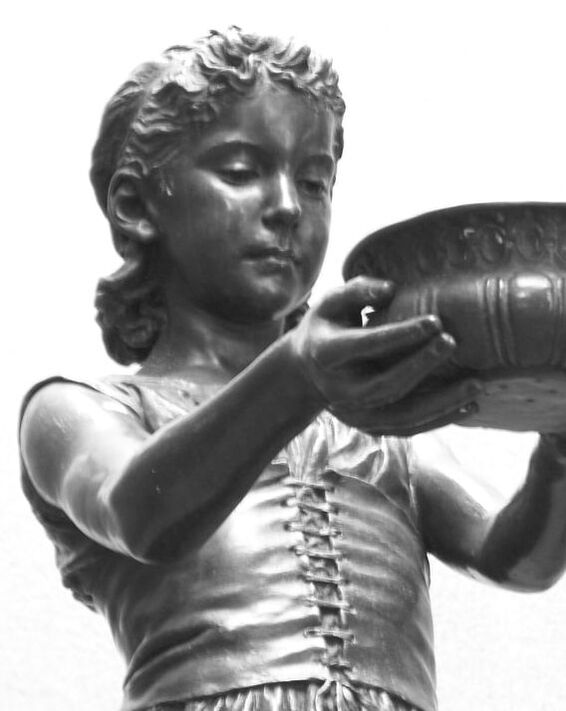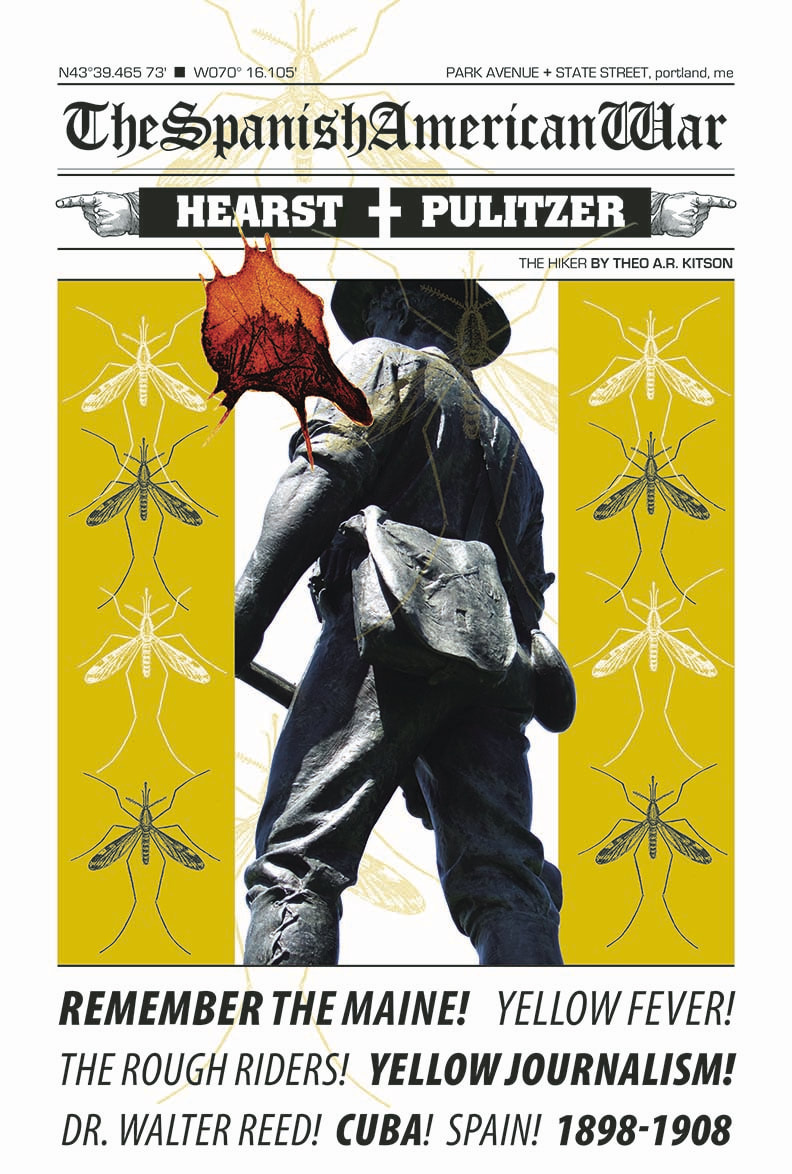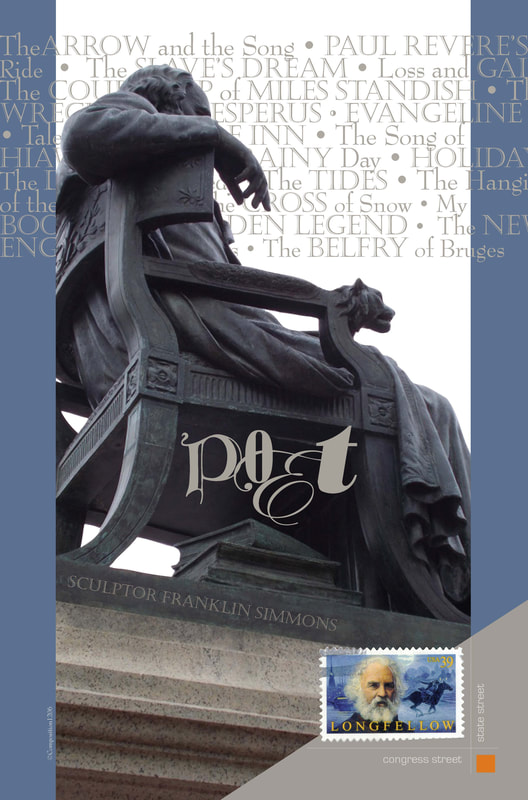|
The first time I saw her, she was tucked in a corner behind bars in the entryway to the Portland Public Library. I might not have noticed her that day, or any other, if it wasn’t for the whirlwind of dried leaves and rubbish swirling at the base of the statue. It was the Little Water Girl, a charming bronze statue of a young girl, and I wondered who she was. I did some research and found an amazing story, and it made me wonder about other statues in the city. There’s the The Hiker in Deering Oaks park, the Lobsterman in Canal Plaza, filmmaker John Ford in Gorham’s Corner, and poet Henry Wadsworth Longfellow in Congress Square. Each one revealing more history and intrigue than I could have imagined. I uncovered information about a poet and a filmmaker, yellow journalism, a horse named Madge, Teddy Roosevelt’s Rough Riders, air pollution, prohibition, and the World’s Fair. After doing my research, I wanted a record of what I found, so I wrote essays and created posters for some of the statues. Here are three of them. Little Water Girl Barefoot with outstretched arms, the Little Water Girl is a fitting tribute to the legacy of Lillian Stevens, a dedicated advocate for women and children, and the third president of the Woman’s Christian Temperance Union (WCTU). The WCTU Founded in 1874, to “combat the destructive powers of alcohol and the problems it was causing their families and society,” the WCTU banded together in prayer, protest, and pledge—a pledge of total abstinence from alcohol. Prohibition and Water Fountains In an effort to curb the temptation of saloons the WCTU fought for Prohibition, encouraging members to install public drinking fountains in their communities where “men could get a drink of water without entering saloons and staying for stronger drinks.” The Little Water Girl is one of those fountains. In support of the WCTU, Lillian Stevens a committed and independent woman, traveled by carriage with her horse Madge some 50,000 miles lobbying for Prohibition. Ratified five years after Stevens’s death, Prohibition didn't last, but more than 70 fountains inspired by the WCTU initiative remain standing across the United States, in Canada, England, and Australia. The Little Water Girl by British sculptor George E. Wade was commissioned by the WCTU for display at the World’s Fair in Chicago in 1893. Copies of statue can be found in Chicago, Detroit, and London. Note: Why was the Little Water Girl behind bars? She was moved to the secure, gated entrance to the Portland Public Library after she was vandalized in Deering Oaks park. When the library was renovated, the Little Water Girl was restored as a working fountain and moved inside. Today she greets patrons as they enter the library. The Hiker Although the Hiker is larger than life and perched on a six-foot pedestal, the Spanish War Veterans memorial on the north lawn of Deering Oaks Park is easy to overlook. But do look—it’s a beautiful statue. From the soldier’s wadded and rolled sleeves to the leather satchel reminiscent of today’s messenger bag, the details are captivating. The Hiker is sculptor Theo A.R. Kitson’s most well-known work—more than 50 copies of the statue are installed across the country. Under the rallying cry “Remember the Maine,” the Spanish-American War secured Cuba’s independence and remains one of the shortest wars on record. But that’s only the beginning. Dig a little deeper and fascinating tales of science, circumstance, and cowboys emerge. For it was during the Spanish-American War that army medical scientist Dr. Walter Reed isolated the cause and stemmed the transmission of yellow fever plaguing the troops; eager journalists and competing publishing magnates gave rise to the dirty business of yellow journalism; and Teddy Roosevelt’s volunteer militia, The Rough Riders, found glory. It was a short war, but a war with a decidedly jaundice pallor. Note: There were at least 50 copies of The Hiker cast and placed in cities across the United States from Texas to Minnesota, and Georgia to Maine. Here’s a list of cities where The Hiker was installed. See if there’s one where you live. Henry Wadsworth Longfellow He broke bread and corresponded with the likes of Nathaniel Hawthorne, Mark Twain, Harriet Beecher Stowe, Oscar Wilde, and Charles Dickens. Born in Portland, Maine, Henry Wadsworth Longfellow was a linguist, professor, and poet. A graduate of Bowdoin College, Longfellow yearned for a life in literature. And so it was. Under agreement with his alma mater, he set out across the Atlantic to study European language and literature. He would return to teach at Bowdoin and then at Harvard College, but writing would prove to be his vocation. Longfellow's well-known works include Evangeline, “The Wreck of the Hesperus,” and “Paul Revere’s Ride. He was a best-selling author and enjoyed considerable success with his work but he suffered tremendous loss in his personal life. His first wife and childhood friend, Mary Storer Potter, died following a miscarriage. And his second wife, Fanny Appleton, with whom he had six children, died after setting her dressing gown afire with candle wax. Forever saddened, Longfellow did little writing after Fanny’s death. Sculptor Franklin Simmons’s bearded Longfellow sits with a stack of books at his feet and scroll in hand. Like Longfellow, Simmons was born in Maine and became a well-known artist in his day. A second sculpture by Simmons, Our Lady of Victories stands just blocks away in Monument Square in downtown Portland. How could you interpret statues and landmarks where you live?
0 Comments
|
Whistlestop Blog
Enjoy a story and find inspiration to write one of your own. Categories
All
|




